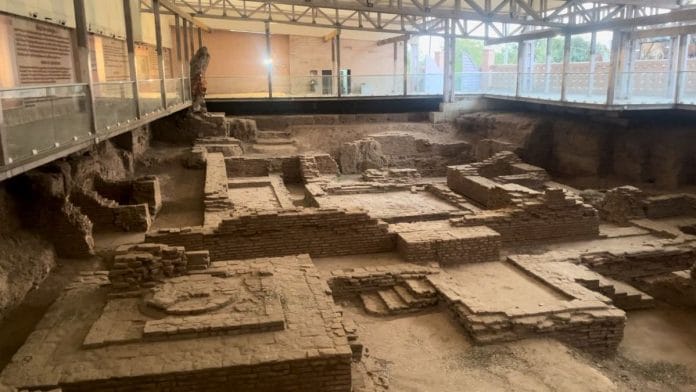New Delhi: In the past five years, the Archaeological Survey of India (ASI) has allocated nearly 25 percent of its total excavation expenditure to Gujarat, the home state of Prime Minister Narendra Modi. For excavation in Modi’s hometown Vadnagar, the department allocated Rs 8.03 crore, which is 94 percent of the total amount of Rs 8.53 crore allocated to Gujarat, according to an analysis by ThePrint of data presented in Parliament.
Between 2020 and 2024, the ASI excavated the Vadnagar site every year. Other sites in Gujarat excavated during this period are Valabhipur, Vihar, Sarwal and Lothal.
Between 2020 and 2024, the ASI conducted excavations at 58 sites across 17 states at a cost of Rs 34.81 crore, Union Culture Minister Gajendra Singh Shekhawat informed Rajya Sabha on 24 July in response to a question by Rajya Sabha MP from Kerala A. Rahim.
In his reply, the minister said 6 excavations each had been carried out in Gujarat, Madhya Pradesh and Odisha during this period, followed by 5 each in Haryana and Uttar Pradesh, and 4 each in Bihar, Tamil Nadu and Rajasthan.
Of the total expenditure of the last five years, ASI spent more than 50 percent on six sites—Vadnagar (Gujarat), Rakhigarhi (Haryana), Kaserua Khera (Haryana), Ratnagiri (Odisha), Bahaj (Rajasthan), and Adhichanallur (Tamil Nadu).
ASI’s budget also increased in the last few years from Rs 1,036.41 crore in FY 2019-20 to Rs 1,278.49 crore in FY 2025-26. “In the past years, the pace of excavation has increased and more and more sites have been excavated across the country,” a senior ASI official who did not wish to be named told ThePrint.
However, less that 1 percent of the ASI budget is spent on actual exploration and excavation. The Comptroller and Auditor General (CAG) of India also highlighted this issue in its 2022 report. Earlier that same year, the Ministry of Culture had assured Parliament’s Public Accounts Committee that it would increase the amount spent on exploration and excavation activities to 5 percent of the total budget.
But as the CAG report pointed out, “Despite the assurance given by the Ministry, ASI’s expenditure on excavation and exploration activities was still less than 1 percent.”
Even today, the allocation for exploration and excavation remains about the same.
Haryana’s Rakhigarhi, the biggest Harappan site, is among the top gainers in terms of funds allocated for excavations. The ASI spent Rs 1.86 crore on excavations here between 2020 and 2024, which is 34 percent of the Rs 5.47 crore allocated to Haryana.
In the excavations at Rakhigarhi, the ASI unearthed evidence of a well, ancient mud-brick structures, a mud-brick stadium and a water storage area.
During this period, a total of five sites in Haryana—Thed Mound in Sirsa, Rakhigarhi, Kaserua Khera, Asandh and Agroha—were excavated.
Following Rakhigarhi in terms of allocation of funds, Rs 1.83 crore was spent in Kaserua Khera which was excavated in 2022 and 2023. This site is known for its rich cultural deposits and excavations have revealed artifacts from the Painted Grey Ware (PGW) period (1100–800 BCE), also referred to as the ‘Mahabharata period’.
However, this year ASI didn’t give licences for excavations at many sites across the country, including Rakhigarhi (Haryana) and Rajgir (Bihar), said sources in the ASI.
Also Read: ASI to join gold rush at MP’s Asirgarh Fort after Chhaava triggers frenzied amateur excavations
Keezhadi Excavation
Kerala MP A. Rahim also inquired in Parliament about funds allocated to the Keezhadi excavation in Tamil Nadu in the past five years, but no data was provided by the ministry concerned in this regard.
The Keezhadi site has become a political flashpoint after archaeologist Amarnath Ramakrishna was asked to make “necessary correction” in the draft report as per “suggestions of the experts”.
“The ASI had identified the archaeological potential of Keezhadi after conducting a systematic survey in the Vaigai river basin. The site was taken up for excavation for the seasons 2014-15, 2015-16 and 2016-17, which revealed rich archaeological remains. Since 2018, the Tamil Nadu State Department of Archaeology is conducting excavation at the site of Keezhadi,” said Shekhawat in his reply.
Of the Rs 3.43 crore allocated to Tamil Nadu, Rs 2.11 crore was spent on the Adichanallur site that the ASI excavated from 2021 to 2024. This site is known for its rich Iron Age megalithic burial site, and excavations have revealed artifacts such as urns, other pottery and evidence of a settled civilisation. In the Union Budget of FY 2020-21 this site was one of the five archaeological sites declared to be developed as ‘Iconic Sites’.
The ASI, established in 1861 is the primary body responsible for archaeological research and excavation in India.
(Edited by Viny Mishra)
Also read: Keezhadi excavation report under review—Centre on ASI’s tussle with archeologist






